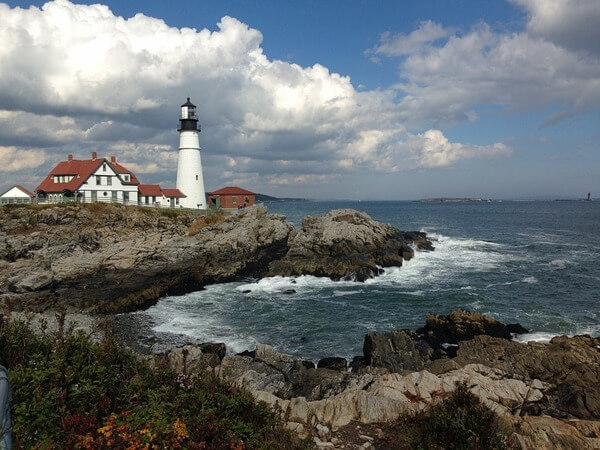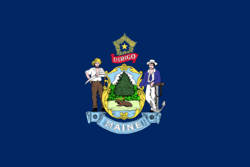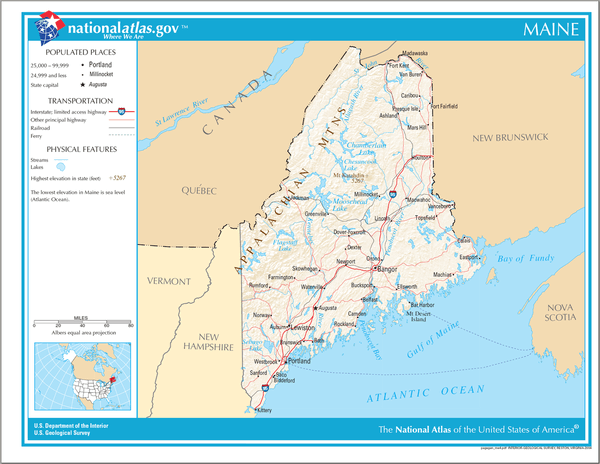About Maine
Stagnant population growth, decreased prime-age labor force participation, and a rapidly aging workforce have contributed to a skills gap across critical industries, producing New England’s slowest-growing post-recession economy. Efforts to foster good-paying manufacturing jobs, coupled with workforce training, could bolster the state’s economy and expand workforce opportunities for Mainers.
Extensive research and more than twenty interviews with stakeholders and experts in Maine have identified offshore wind as a promising economic engine and job creator. Offshore wind turbines harness the power of strong ocean winds by generating energy from faster, more consistent wind speeds and can be leveraged to meet the vast energy needs of coastal states, particularly across the North Atlantic. Given Maine’s research in next-generation technologies, local suppliers and expertise, and large offshore wind resource potential, the state is positioned to benefit from long-term market growth in this region. With mass production, electricity rates for offshore wind will decrease to approximately 7.7 cents per kWh.
Through the offshore wind manufacturing industry, Maine can leverage its numerous strengths to take advantage of expanding opportunities, such as:
- Capitalizing on growing technology demand for offshore wind. The offshore wind industry is projected to grow 16 percent annually through 2030.
- Benefiting from regional market growth. Maine has an opportunity to mobilize the offshore wind market in the Northeast, supplying expertise and products to facilitate the expected build-out of 7.5 GW of installed offshore wind capacity.
- Harnessing natural resource potential. Maine has the offshore wind resources to generate about 156 GW of electricity.
- Leveraging existing resources for manufacturing and production. Maine is home to concrete production, manufacturing facilities, and other assets that can be used to locally construct wind turbine components, such as floating foundations.
- Mobilizing cutting-edge research and development. The state can engage its academic and research networks to capitalize on local innovations in floating foundation technology.
- Supporting quality, local jobs statewide. With forward-thinking solutions, offshore wind could support 2,144 Maine jobs annually through 2030.
To realize these opportunities, state and local leaders can pursue strategies that create a strong foundation for industry growth in Maine and help local businesses grow, innovate, and outcompete regional, national, and global competitors. In today’s competitive, globalized economy, businesses are more likely to thrive in cities and states that offer clear policy signals, a rich innovation ecosystem, fertile ground for capital investment, and a highly skilled workforce. By having a close network of suppliers and partners, companies in Maine can reap the benefits of increased productivity and operational efficiency, amplifying local job creation and economic growth.
This opportunity offers real benefits for the state economy and Maine residents. Annually through 2030, offshore wind can support a total of 2,144 direct jobs from manufacturing and material development, indirect jobs from suppliers, and induced jobs from spending in the local economy. This industry offers a diverse array of good-paying jobs that cater to different education and experience levels. Policymakers can support these jobs by seizing the opportunity presented by increasing global demand and overcoming barriers to industry growth. Build-out of the offshore wind industry will require clear policy signals, collaborative efforts, continued assessments, policy planning, and steady-handed leadership in order to surmount the unique challenges of this nascent industry.
Summary of Recommendations
The analysis presented in this report culminates in recommendations for Maine’s leaders based on best practices in the United States and abroad. Each recommendation identifies strategies to address barriers to industry growth or capitalize on untapped opportunities in the offshore wind industry. Specifically, Maine could target challenges in each foundational building block: local market growth for offshore wind technology, value chain build-out, the innovation ecosystem, access to capital, and workforce development. While the recommendations are intended to be complementary and would be more powerful if adopted as a package, each can also be viewed as a stand-alone option. Maine policymakers and stakeholders should use this guide for collaboration and prioritization of policy actions given the opportunities and challenges that lie ahead in growing the offshore wind industry.
Map of Maine (Image: National Atlas)
Local Market
Assess Future Procurement Options for Offshore Wind
Exploring future procurement options beyond a standard power purchase agreement (PPA) could ensure that future projects have multiple options for economic viability. Moreover, policymakers could consider procurement requirements that include local labor, as seen in Illinois.
Re-Establish the Maine State Planning Office
To encourage independent analyses, support effective long-term energy planning, and facilitate offshore wind development, Maine policymakers should consider re-establishing the State Planning Office. Given the challenges associated with the development of offshore wind projects, a dedicated staff will need to assess barriers, costs and benefits, and strategies for the proper mobilization of resources to support the industry.
Create an Offshore Wind Production Tax Credit
Maine could create an Offshore Wind Production Tax Credit to send a clear policy signal to foreign and domestic investors that Maine is committed to developing offshore wind and attracting good-paying, middle-class jobs to the state.
Value Chain
Bolster Foreign Direct Investment
To help support a robust offshore wind cluster in Maine, state officials could leverage foreign direct investment (FDI) programs to provide targeted assistance to international businesses that can act as in-state anchor companies and fill critical gaps in the value chain.
Establish an Anchor Company Tax Credit
Maine could support the build-out of the offshore wind industry by establishing an anchor company tax credit to recruit key component manufacturers needed to meet in-state demand and develop a locally-sourced value chain to ease logistics and operations.
Modernize Economic Development Strategies
Maine could leverage strategic marketing and outreach efforts such as developing modest improvements in the state’s brand, website, and media strategy to attract and expand new businesses in the state.
Upgrade Ports and Establish a Port Innovation District
Maine could target investments in strategic offshore wind cluster development around deepwater ports, including upgrading ports and creating nearby innovation districts.
Consider Updates to Tax Increment Financing
Tax increment financing (TIF) is a municipal development financing tool that can yield economic benefits such as the creation of innovation districts or port upgrades. However, Maine could benefit from updates to TIF legislation that ensure proper oversight and stakeholder engagement while also considering additional factors relevant to offshore wind.
Innovation Ecosystem
Establish a Northeast Offshore Wind Innovation Center
Maine could establish a Northeast Offshore Wind Innovation Center to coordinate regional offshore wind R&D efforts, foster engagement with important industry players, leverage investments from federal and state governments, and set and achieve goals related to floating foundation technology.

Lighthouse at Portland Head (Image: Pixabay)
Access to Capital
Establish an Offshore Wind Business Development Fund for Small Businesses
Maine can help emerging businesses overcome barriers to entry in the offshore wind market by providing targeted support to early-stage manufacturers of wind turbine components such as foundations, towers, and blades as well as assistance to businesses engaged in design and engineering, siting and permitting, transportation, and storage.
Raise or Eliminate the Annual Cap on the Maine Seed Capital Tax Credit Program
To foster an active startup culture and thriving entrepreneurial environment, the Maine Legislature could raise or eliminate the annual cap on the Maine Seed Capital Tax Credit to motivate investors to finance potentially higher-risk, higher-yield ventures and provide more capital than would have otherwise been invested.
Appoint a Foundation Liaison to Target Program-Related Investments and Seek Funding for Advanced Energy Programs
Maine could appoint a Foundation Liaison to develop relationships with and broker support from large national foundations engaging in program-related investments. Maine could leverage foundations’ funding mission and resources to facilitate support for in-state advanced energy companies.
Workforce Development
Form an Offshore Wind Workforce Development Fund
By offering financial and technical support to its workforce development organizations, Maine could ensure a strong pipeline of workers at each stage of industry growth, including site survey and development, manufacturing, construction and installation, and operations and maintenance.
Establish Offshore Wind Programs at Community Colleges
Maine could facilitate the growth of its offshore wind industry and help create a qualified workforce by expanding access to wind certificate and degree programs at community colleges. The colleges could provide students with hands-on training in wind turbine maintenance and electrical power production while also emphasizing fundamental electrical and mechanical concepts.
Promote Apprenticeship and Career and Technical Education Programs
Maine could improve its education and employment figures by expanding apprenticeships and career and technical education (CTE) programs, helping residents gain the workforce training needed to participate in emerging industries such as offshore wind.
- Source:
- American Jobs Project
- Author:
- Press Office
- Link:
- americanjobsproject.us/...
- Keywords:
- Maine, USA, jobs, offshore wind, colleges, education, workers




























